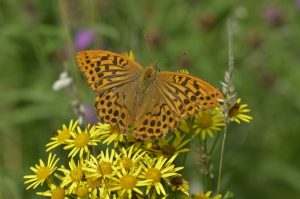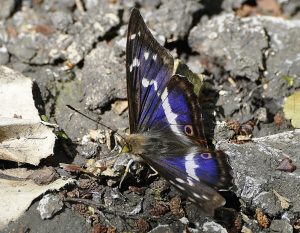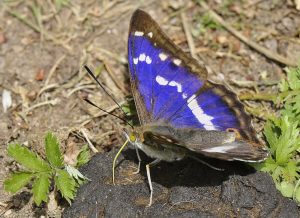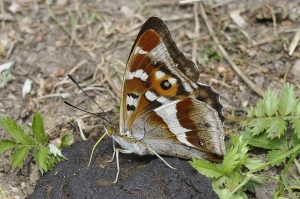Although we are not well blessed in Rushcliffe with some of the more colourful butterflies found further south – various blues and fritillaries – we are fortunate enough to have, in Cotgrave Forest, small local populations of two of the ‘best’ butterfly species, Silver-washed Fritillary and Purple Emperor.
For decades, if not centuries, the Purple Emperor has held a special place for butterfly enthusiasts. Its scientific name Apatura iris was established by two eminent 18th century naturalists, Carl Linnaeus and Johann Christian Fabricius and, like many butterfly names, was based on Greek mythology and classical writings. Iris was the winged messenger of the gods, the shimmering personification of the rainbow; Apatura is possibly more of a made-up word, based on one of the names of Aphrodite and a Greek word meaning to deceive. Peter Marren suggests the name reflects ’a question of now you see, now you don’t; one moment the butterfly is sombre brown and the next, an eye-wateringly brilliant purple.’ Victorian butterfly collectors called it ‘His Imperial Majesty’ (or HIM) and enthusiasts from across the country continue to make the pilgrimage to Fermyn Woods in Northamptonshire, and similar sites across southern counties in the hope of seeing HIM.
So, reports in 2015 of Purple Emperors at Cotgrave Forest prompted a great deal of excitement. I immediately went looking but failed to find any. Mind you, I did go to the wrong place! 2016 was equally unsuccessful (in the right place this time), but then came June 2017. On a lovely sunny morning I went to the spot where, I had been assured, Emperors were to be seen and spent a good half hour looking up – without luck – at the top of the oaks, the usual habitat of these elusive creatures. Thinking I had drawn another blank, I made to go, but a movement on the floor caught my eye – my first Rushcliffe Purple Emperor! Paradoxically, it was not the soaring beauty of imagination: with its wings closed it walked along in what can only be described as a robotic waddle.
It was clearly undisturbed by my presence, so I followed, watching, until it stopped and opened its wings which, although attractively marked, were disappointingly (and deceptively) brown rather than purple. And then the magic happened. Turning and lifting its wings slightly to the right angle, the light refracted through the scales and a glorious purple iridescence transformed the animal from ordinary to extraordinary – a male Purple Emperor in all his glory.
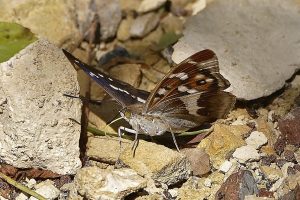
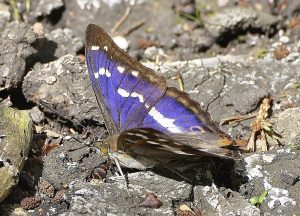 For the next hour or so, I was in butterfly heaven, as at least two different males allowed me to observe and photograph them at close quarters, able to see not only the wondrous iridescent upper wings, but also the beautifully-patterned underwings and the striking sulphur yellow proboscis as they fed on unidentified animal poo, fighting off a Red Admiral, a Comma and a Small Tortoiseshell for the privilege.
For the next hour or so, I was in butterfly heaven, as at least two different males allowed me to observe and photograph them at close quarters, able to see not only the wondrous iridescent upper wings, but also the beautifully-patterned underwings and the striking sulphur yellow proboscis as they fed on unidentified animal poo, fighting off a Red Admiral, a Comma and a Small Tortoiseshell for the privilege.
Unlike other butterflies, the Purple Emperor seldom, if ever, feeds on flowers. Most butterfly books describe their diet as a mix of aphid honeydew that coats broadleaved trees in summer and tree sap, often flying long distances to bleeds on trees where the sap weeps and congeals, although latterly Matthew Oates in His Imperial Majesty contests strongly that it is sap alone that forms their diet.
In search of minerals and salts, male Emperors come down to feed on what are, to many, rather disgusting foods such as dung and rotting flesh (or, as Matthew Oates more politely puts it ‘a diversity of naturally occurring substances on the woodland floor’). Consequently, people use all manner of concoctions to tempt males down for a closer view. In The Butterfly Isles, Patrick Barkham describes a number of these, and includes an image of an Emperor feeding on Shito, ‘an evil-smelling fish paste from Ghana’.
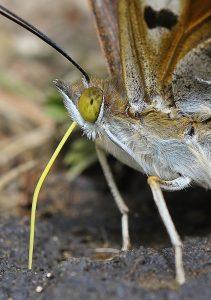 Questionable dietary practices aside, the Purple Emperors I was privileged to get close to were some of the most strikingly beautiful creatures one can imagine, and I was sad to leave but happy to have seen them. I have been back to Cotgrave Forest most years since – lockdown permitting – and had a number of sightings of Emperors in flight; perhaps this year I might get close to them again.
Questionable dietary practices aside, the Purple Emperors I was privileged to get close to were some of the most strikingly beautiful creatures one can imagine, and I was sad to leave but happy to have seen them. I have been back to Cotgrave Forest most years since – lockdown permitting – and had a number of sightings of Emperors in flight; perhaps this year I might get close to them again.
In our post ‘Silver-washed Fritillaries in South Notts’ (click here to view), we describe the arrival in 2013 of this other wonderful butterfly into Rushcliffe, as part of what may be a natural range expansion northwards, and how it too can be found regularly in Cotgrave Forest. The arrival in 2015, or earlier (see below), of the Emperor led me to wonder whether this was a similar consequence of range expansion, or an introduction, or had they always been there without being recorded?
Trevor Pendleton, on the Eakring Birds website, looks at historical records in the county, referencing J.W. Carr’s book The Invertebrate Fauna of Nottinghamshire. Nottingham: J.& H. Bell Ltd (1916). According to Carr, the late 19th century saw sightings around Sherwood Forest, with a record as far south as Newark, but by 1916 the butterfly was ‘very rare’. Trevor suggests there were apparently some documented records from Sherwood Forest and Clumber Park in the 1970s and 80s, but describes a degree of secrecy and reluctance to share sighting data.
He states that there are no similar historical records from Cotgrave Forest, which was felled during WWII, presumably as part of the war effort; it was replanted a decade or so after the end of the war. He says ‘…and if colonisation at Cotgrave Forest was indeed naturally occurring, it was likely earlier than is supposed. Remember, any species (sometimes no matter how obvious they are) can be easily missed, especially if it’s not suspected as being there’.
Trevor notes the Purple Emperor population at Cotgrave Forest has been reported since 2015, but was believed to have been present for at least a year or two before. He believes there is still some confusion regarding the origins of the butterfly at this site, acknowledging the possibility of an artificial introduction (a ‘release’), but concludes ‘ Personally, I think it is more likely that it’s there as part of a natural range expansion, which had been recorded over the border in neighbouring Leicestershire and Rutland by Richard Jeffrey’.
Matthew Oates says that historically the Purple Emperor was first recorded in the county in 1859, and to ‘have been reasonably well known from the Sherwood area around the turn of the nineteenth century, and in the woods to the east’; he says the last records come from 1939 at Mansfield, Sherwood Forest and towards Newark, after which they either died out or became undetectable.
He then asserts that the Purple Emperor was introduced to Cotgrave Forest in the mid-1960s, with some later topping up, adding ‘Curiously, the butterfly’s presence there remained a secret, or undetected until 2015’ Interestingly, he follows this by saying ‘Perhaps it resurged during the great Emperor season of 2013’ – does this accept the possibility of a natural phenomenon?
Neil Pinder, on the Rushcliffe Wildlife website, confirms that one (or more) Emperor was seen in Cotgrave Forest in 2015,and was told by a keeper that he had seen them there for the previous few years (but not known what they were and he had not reported them). Neil accepts the 1960s introductions, but argues that naturalists have visited Cotgrave for years without finding Emperors and concludes that a suggestion of a population undetected for more than 50 years is ‘absurd’. He believes the 1960s introduction failed, and alludes to more recent introductions of a ‘secretive nature’, and that everything points to the suggestion of a more recent introduction.
So, where does that leave us? Are too many ‘what ifs’ to be certain?
On the one hand, there is a case to support ‘natural’. Purple Emperors were historically present in the county, and in counties to the south. They are big, strong-flying insects quite capable of flying relatively large distances to colonise away from their ‘normal’ locations. Their behaviour is unlike most other butterflies, in that they spend much of the time in the tree canopy, and most people, I think, look at ground level for butterflies, so may not see them, particularly if they are not aware of their likely presence. Both Trevor and Neil use the word ‘secretive’ to suggest a possible conspiracy of silence and lack of data sharing.
On the other hand, there is evidence of an introduction in the 1960s although Neil makes a very strong case for that not to be a potential source, so perhaps we are left with more recent introductions. Unfortunately, we are probably unlikely to ever know: if certain people ‘in the know’ remain secretive about sightings, I cannot imagine there would be an appetite for openness about (unauthorised) introductions.
Irrespective of origin, there is recent evidence of a widening population in Nottinghamshire: in 2021, as well as being seen in both Sherwood and Cotgrave Forests, Emperors were recorded at Mansfield, Farndon, Calverton and Bramcote Park, and in 2022 at Epperstone, West Leake Hills and West Bridgford (source: iRecord).
So let’s just accept that however it got here, the Purple Emperor is here, hope it keeps expanding its range, and marvel at one of the wonders of the insect world present on our doorstep.
There is a note of caution, though, for the immediate future: Trevor Pendleton reports on potentially significant impacts on egg and larvae numbers consequence of last summer’s extreme heat, which may depress Emperor numbers in the coming year.
Chris Overton January 2023 Images: Chris Overton ©
If you would like a PDF version of this article, click here.
SOURCES
Matthew Oates. His Imperial Majesty A natural history of the Purple Emperor. Bloomsbury Wildlife 2020
Peter Marren. Rainbow Dust Three Centuries of Delight in British Butterflies. Square Peg. 2015
Jeremy Thomas & Richard Lewington. The Butterflies of Britain & Ireland. BritishWildlife Publishing Ltd 2010
Patrick Barkham . The Butterfly Isles. Granta Books 2020
Chris Overton. Silver-washed Fritillaries in South Notts http://www.southnottswildlife.org.uk/content/?p=1921
Trevor Pendleton. The origins of the Purple Emperor in Nottinghamshire https://www.eakringbirds.com/butterfliespurpleemperor.htm
Trevor Pendleton. Sherwood’s purple Disaster https://www.eakringbirds.com/butterfliespurpleemperor2022.htm
Neil Pinder. The Butterflies of Rushcliffe. https://rushcliffewildlife.co.uk/butterflies.html
iRecord. https://irecord.org.uk/

